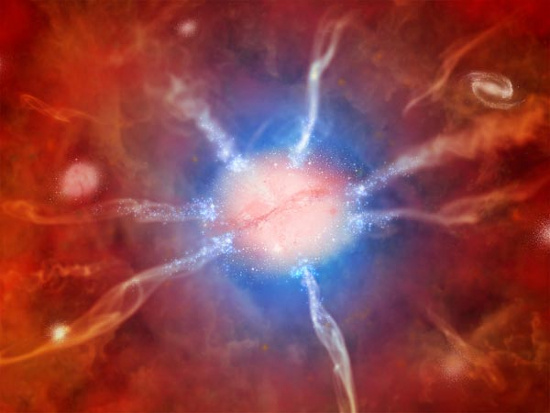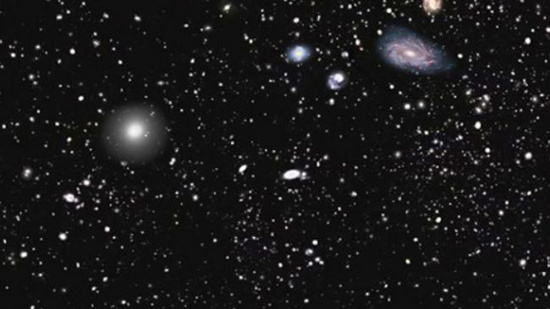The most impressive findings about the universe in 2012 (2)
The astronomical industry welcomed the impressive discoveries in 2012, which changed the way people knew about the universe, and pushed some devices to the critical level of their capabilities.
Beam of the largest galaxy

The Phoenix constellation was given the ability to produce
born about 740 new stars every year - (Photo: NASA)
Larger than the Milky Way to 2,000 times, a giant cluster of galaxies about 7 billion light-years from Earth can disgrace any material gathering in the universe.
Astronomers say the galaxy, called SPT-CLJ2344-424 3 , or the Phoenix, seems to contain thousands of galaxies of all sizes.
Experts have been eyeing the Phoenix for the first time in 2010, but it is not known if they have discovered a true 'monster' . By analyzing observational data from NASA's Chandra X-ray observatory, they were stunned by its size.
High-energy light streams emanating from the galaxy beam make it the most brilliant material mixture ever discovered, 35% brighter than the previous "record" .
Largest map of the universe

Impressive map of 1 million galaxies - (Photo: Johns Hopkins University)
The third Sloan electronic sky survey yielded perfect results: mapping more than 1 million galaxies with a total mass of up to 70 billion light-years.
This map can greatly support astronomers in their efforts to understand the evolution of the universe, such as the nature of dark matter and mysterious dark energy.
The deepest insight into the universe

The picture includes 10 years of Hubble observation data - (Photo: NASA)
The Hubble Space Glass is "poking" deeper into the universe's past. The famous observatory captured light emitted 13.2 billion years ago, when the new universe was 500 million years old.
The image is called eXtreme Deep Field, which shows galaxies and synthesized light from stars that accumulate for 10 long years in a narrow sky. This is the best method if you want to see objects that are too far away.
The most magnetic star

Expert's magnetic star - (Photo: ESA)
About 20,000 light-years from Earth, a star receives special attention from astronomers.NGC 1624-2 , 35 times the size of our sun, belongs to the constellation of the English Fairy, with strong magnetic properties.
With a magnetic field 20,000 times stronger than the sun, and 10 times more than any other star ever discovered, NGC 1624-2 is covered by a curtain of particles of charge in the control of it.
'The magnetic field at this level is very rare, it only exists in a few other stars with much lower mass ratios , ' said lead researcher Gregg Wade, an astronomer from the Royal Canadian Military University. . He admitted they were very lucky to find such a powerful magnetic field.
X-rays flow from the early universe

X-ray flow exceeds 12.2 billion light-years to reach Earth - (Photo: NASA)
A stream of X-rays emanating from GB 1428 quasars was found about 12.4 billion light-years from Earth. Estimated, its radiation range extends twice the diameter of the Milky Way.
With this discovery, astronomers say they are gathering more information about the behavior of black holes in the early days of the universe.
The largest galactic core

The giant elliptical galaxy is a dazzling member
most of the galaxy beam Abell 2261 - (Photo: NASA)
Lurking in a galaxy 10 times the Milky Way is a giant core, not a usual black hole.
The A2261-BCG core , which is about 10,000 light-years across, has really embarrassed the experts, because it should have been at the center of most galaxies.
Based on data from Hubble, it seems that the upper core formed when two galaxies merged together.
- The most impressive findings about the universe in 2012 (1)
- 10 most impressive findings in 2010
- Impressive cosmic images in the month
- Photo of the impressive universe last week
- Amazing universe through the most impressive photos of 2018
- Photo universe impressive week
- Photo of the universe: The star is 150 times brighter than the Sun.
- Discovering the universe 'most lonely' universe
- Beautiful universe photos in the month
- Revealing the first fireworks photo in the universe
- Impressive astronomical photos in the month
- Beauty of the universe in the week
 Van Allen's belt and evidence that the Apollo 11 mission to the Moon was myth
Van Allen's belt and evidence that the Apollo 11 mission to the Moon was myth The levels of civilization in the universe (Kardashev scale)
The levels of civilization in the universe (Kardashev scale) Today Mars, the sun and the Earth are aligned
Today Mars, the sun and the Earth are aligned The Amazon owner announced a secret plan to build a space base for thousands of people
The Amazon owner announced a secret plan to build a space base for thousands of people World's most powerful telescope captures something that threatens to upend cosmology
World's most powerful telescope captures something that threatens to upend cosmology  'Time-traveling assassin' 13 billion years ago kills an entire galaxy
'Time-traveling assassin' 13 billion years ago kills an entire galaxy  The mystery of human lifespan limits
The mystery of human lifespan limits  13 'alien' skulls next to Mayan pyramids
13 'alien' skulls next to Mayan pyramids  How long does it take to reach another star system besides the Solar System?
How long does it take to reach another star system besides the Solar System?  For the first time, 5 super-objects from 13.6 billion years ago have been revealed.
For the first time, 5 super-objects from 13.6 billion years ago have been revealed. 